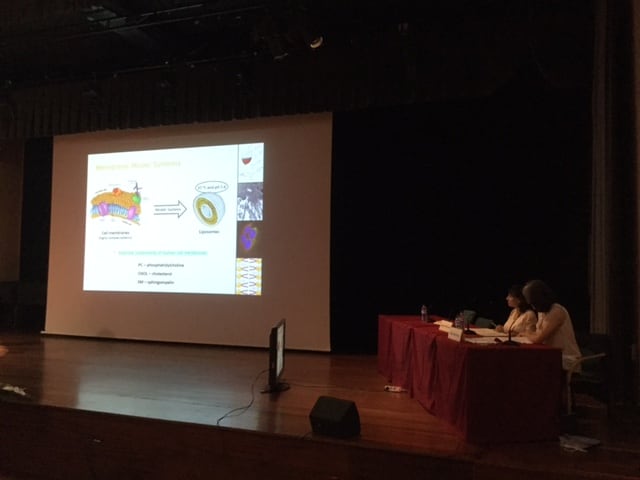Polyphenol-enriched diets were a subject of discussion for a handful of speakers with its protective effects already well-established, and the potency of associated foods taking centre stage.
Dr George Pounis, researcher at the Neuromed Institute in Italy, sought to measure the influence of a polyphenol-enriched Mediterranean diet on low-grade inflammation.

Here, Pounis presented data that negatively linked flavonoid and lignin intake with a number of low-grade inflammation biomarkers - established risk factors for conditions including cardiovascular, cerebrovascular and neurodegenerative diseases.
Pounis and his team enrolled subjects that made up the Moli-Sani study, a population-based cohort study of 24,325 people living in the Molise region of Italy.
“To exploit its [the diet’s] health advantages it is important to adhere to all the various combinations of food and nutrient components that have been described and graphically presented in the shape of a pyramid,” said Pounis.
“In terms of micronutrient intake we should focus on the antioxidant vitamins C, A and E, tocopherol-β, -γ and -δ, carotene-β and -α, lycopene, all different classes of polyphenols, omega-3 fatty acids and some minerals.”
He concluded that the diet as an eating behaviour model could also offer weight management benefits along with advantages in the primary and secondary prevention of chronic diseases.
The SU.VI.MAX cohort
Dr Solia Adriouch also came to a similar conclusion claiming dietary polyphenols helped to reduce weight gain over time.
Her presentation detailed a less notable increase in body mass index (BMI) in subjects with the highest intake of flavones, lignans and total polyphenols.
A less noticeable increase in waist circumference (WC) was also observed in subjects with the highest intake of procyanthocyanidins, flavanones, flavones, hydroxycinnamic acids, and lignans.
The association of various classes and subclasses of polyphenol intakes with BMI, WC, cardiovascular and death by all-causes were investigated using the (Supplémentation en Vitamines et Minéraux Antioxydants (SU.VI.MAX) cohort – a sample of 6515 subjects monitored over the course of thirteen years (1994–2007).
Such was the subject range and length of study time, a number of other studies have harnessed the cohort’s diversity to draw conclusions that also credit the qualities of polyphenols in other areas.
A study demonstrated that increased intake of polyphenols, including flavonoids and phenolic acids, may also aid in sustaining verbal memory, which is considered a noticeably vulnerable area in the pathological aging of the brain.
Likewise another study took the female contingent of the cohort to suggest that several classes of polyphenols could potentially contribute to breast cancer prevention among non-to-low alcohol drinkers.
Olive oil observations
Other research presented at the meeting chose to focus on phenolic compounds and their cardiovascular conditions.
Findings from the isolation and purification of the olive fruit found the phenols, hydroxytyrosol (HT) and the 3,4-dihydroxyphenylglycol (DHPG) primarily responsible for the oil’s anti-platelet effects.
Further analysis also demonstrated the synergistic effect of both simple phenols in the ratios present in the natural olive fruit.
“We have not determined yet any mechanisms of action to explain the synergistic effect but it is most likely dependent on a combination of activity (antioxidant, anti-platelet aggregation, etc),” said Guillermo Rodríguez Gutiérrez from the Instituto de la Grasa (CSIC), Spanish National Research Council, Spain.
“Phenols aside, the synergistic effect of the other compounds present in olives coupled with their combination in lipo and/or lipophilic media will be an important impact into the food industry.”
Previous analysis has already identified HT and DHPG as having high antioxidant activities, even in lipid peroxidation. DHPG also showed higher antiradical activity than HT and vitamin E.
Olive extracts are currently being used in food formulation to prevent the oxidative damage of the food, increasing the life of the commercial products.
South American flavour

Finally, Dr Maria de la Luz Cádiz-Gurrea from the University of Granada, Spain detailed work that identified a total of 30 compounds in an extract of the Lippia citriodora (lemon verbena) plant.
These compounds belong to various structural classes including iridoids, flavonoids and phenylethanoids, most of them with proven antioxidant and anti-inflammatory activities.
Lemon verbena is a plant indigenous to South America and is widely used in infusions that have antispasmodic, antipyretic, sedative, and digestive properties.
This plant is already used in the food industry to flavour different products. Lemon verbena infusion contains significant amounts of polyphenols with healthy properties including high antioxidant activity.
Cádiz-Gurrea began by isolating compounds in the L. citriodora extract by washing with a solvent. Eleven fractions were collected and each fraction residue was weighted and dissolved with water.
Finally, fractions were filtered and their composition analysed and identified using HPLC-ESI/DAD-TOF-MS - a powerful analytical technique.
Source: Journal of ISANH (International Society of Antioxidants in Nutrition and Health)
Published online ahead of print, DOI:10.18143/JISANH_v3i4
“Mediterranean Diet, dietary polyphenols and low-grade inflammation: Results from the Moli-Sani Study.”
Authors: George Pounis et al.
“Total and specific dietary polyphenol intakes and 6-year anthropometric changes, cardiovascular and all-causes mortality in the middle-aged general population cohort SU. VI. Max, France, 1994-2007.”
Authors: Solia Adriouch et al.
“Synergistic effect of the main simple phenols present in olive oil and olive tables.”
Authors: Guillermo Rodríguez Gutiérrez et al
“Semi-preparative HPLC isolation of bioactive compounds from Lippia citriodora extract: a useful nutraceutical approach.”
Authors: Maria de la Luz Cádiz-Gurrea et al.
